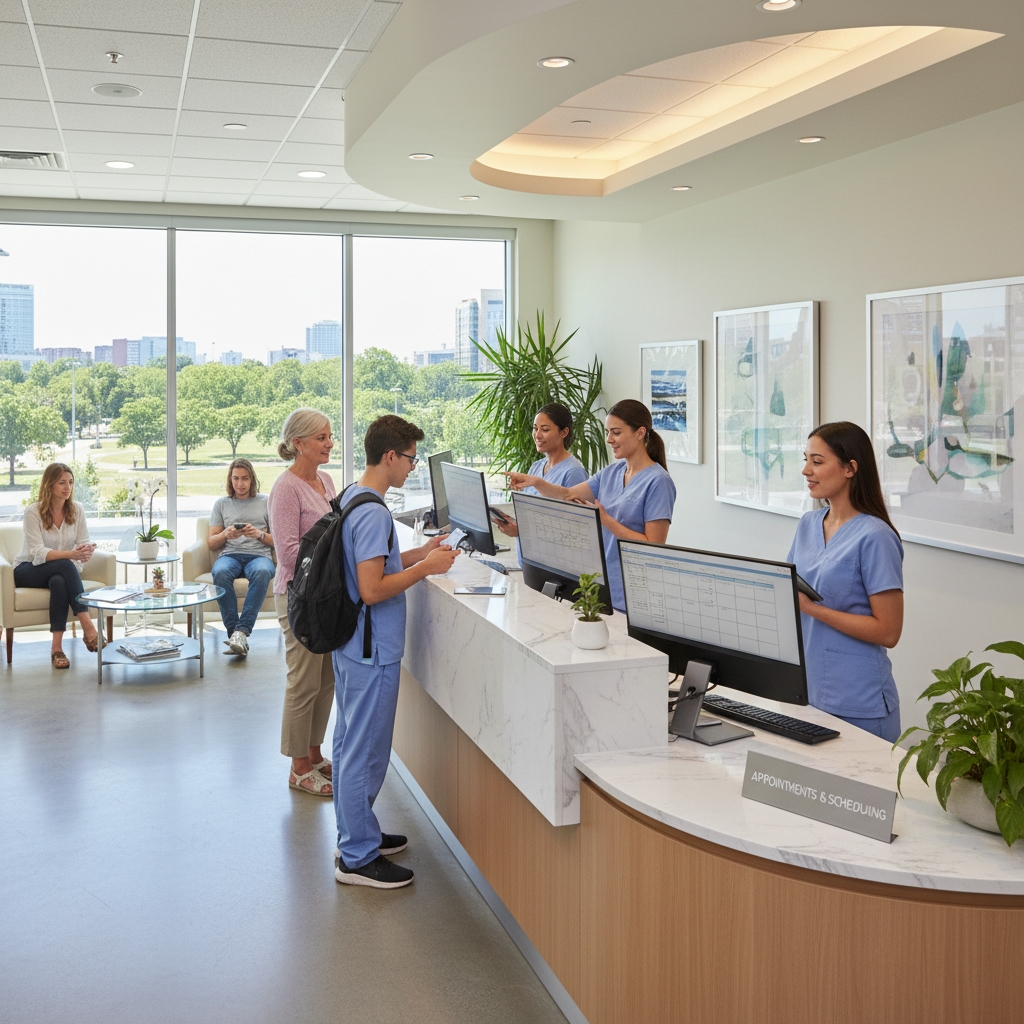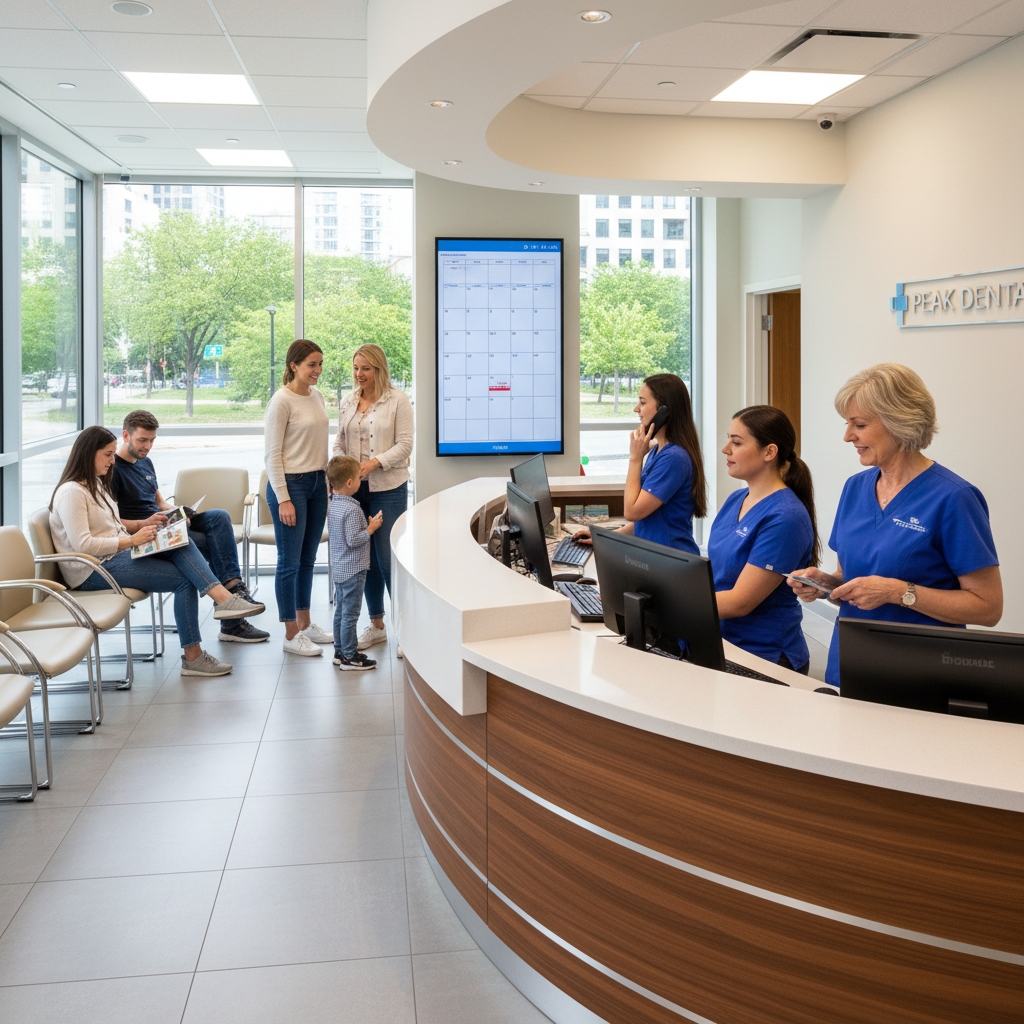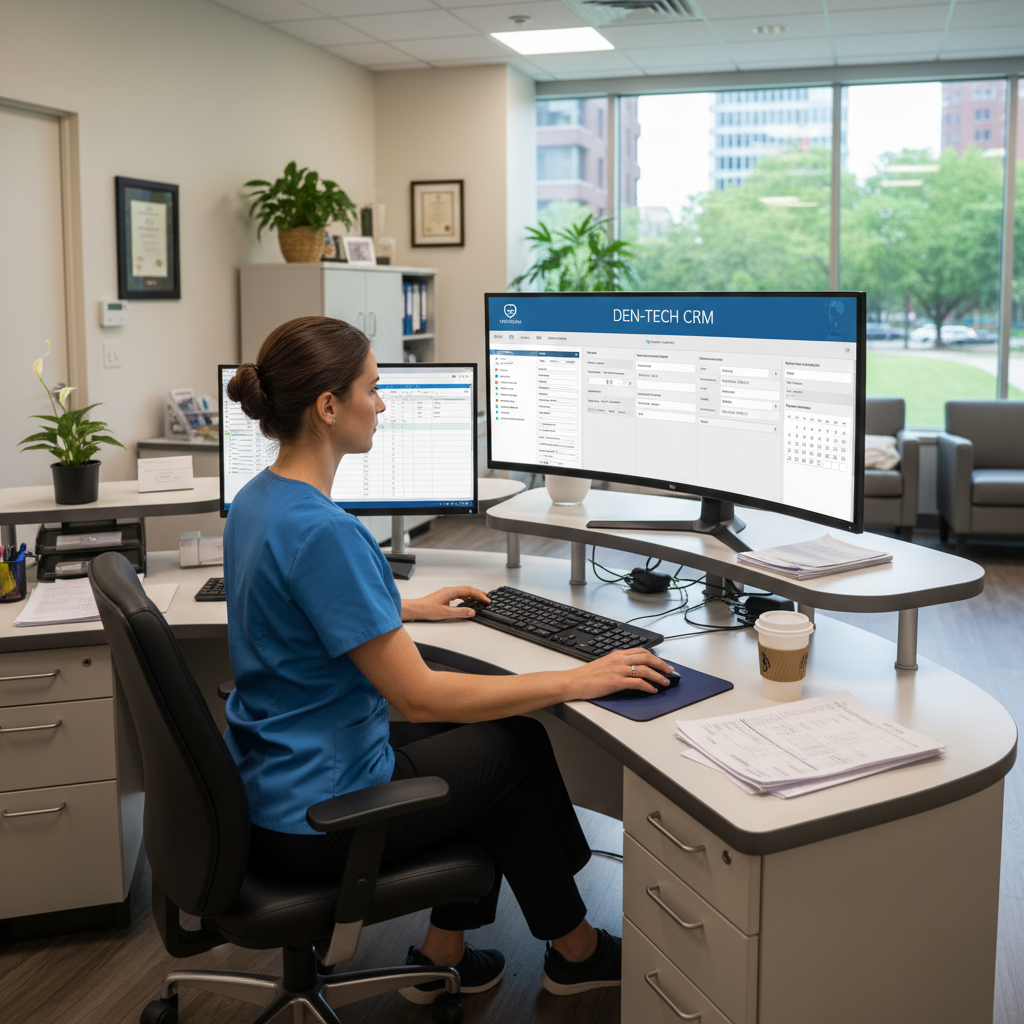












Blog Article


How to Provide Instant Text Responses to Missed Dental Calls - Guide For Dentists and DSOs
Modern automated text response systems can recover up to 60% of missed dental calls by instantly engaging patients with appointment scheduling options and emergency protocols. Dental practices miss 32% of incoming calls from potential patients, creating massive revenue losses that compound over time.
Each unanswered call represents hundreds or thousands of dollars in lost treatment value. Patients experiencing dental pain or needing urgent care quickly move to competitors when practices fail to respond immediately. Traditional callback methods often take hours or days, causing most opportunities to disappear permanently.
Dental Support Organizations face even greater challenges coordinating call management across multiple locations with varying staffing levels and protocols. Instant text response technology eliminates these barriers by providing 24/7 patient engagement that converts missed calls into confirmed appointments automatically, regardless of practice size or call volume.
Key Takeaways
- Automated text systems can recover 60% of missed dental calls that would otherwise become lost revenue
- Instant responses prevent patients from calling competitors during emergencies or urgent dental needs
- DSOs benefit from centralized text response management across all practice locations with consistent protocols
Missed Dental Calls Impact Revenue and Patient Satisfaction
Dental practices lose substantial revenue when calls go unanswered, with average practices missing 32% of incoming calls from potential patients. This creates both immediate financial losses and long-term patient retention challenges that compound over time.
Revenue Loss from Missed Calls
Missed calls create direct financial impact for dental offices. Each practice can lose 71 potential new patients for every 100 calls received, with only 42% of answered calls converting to appointments.
The financial calculations are significant. A typical practice receiving 100 monthly calls could lose $72,000-$108,000 in potential revenue based on industry conversion rates.
Revenue Loss Breakdown:
- 32 unanswered calls per 100 received
- 28 answered calls with poor conversion
- Total missed opportunities: 60+ patients monthly
Emergency calls carry higher immediate value. A single missed emergency appointment costs $500-$1,200 in same-day revenue, plus patients often seek permanent care elsewhere.
Marketing investments amplify these losses. Practices spend $200-$300 per new patient through digital marketing, making each unanswered call a waste of advertising dollars plus lost lifetime patient value.
Patient Retention Challenges
Patient expectations have changed dramatically in recent years. Patients expect immediate responses similar to other service industries they interact with daily.
Patient satisfaction drops when calls go unanswered because dental issues often require prompt attention. Patients experiencing pain or emergencies will quickly call competing practices if their initial call isn't answered.
Long hold times create negative first impressions. When patients call to schedule urgent appointments, waiting increases stress levels and many hang up to call competitors instead.
Key patient frustration points include:
- Busy signals during peak hours
- Lengthy hold times without callback options
- Voicemail-only responses for urgent needs
- Delayed return calls extending scheduling timelines
Patients who experience difficulty scheduling initial appointments show 40% lower retention rates for preventive care visits. This reduces lifetime value significantly beyond the immediate missed appointment.
Peak and After-Hours Missed Calls
Monday mornings and lunch hours create the highest volume of missed calls in dental clinics. Patients typically call to schedule appointments at the beginning of work weeks or during their own lunch breaks.
High-risk time periods:
- 8:00-10:00 AM on Mondays
- 12:00-1:00 PM daily
- 4:00-6:00 PM weekdays
- Weekend emergency calls
After-hours calls present unique challenges because many involve urgent dental issues. Practices without proper after-hours coverage lose emergency patients who generate higher revenue per visit.
Staff scheduling conflicts during peak periods lead to inadequate phone coverage. Front desk employees cannot answer phones while checking patients in, processing payments, or handling insurance verification simultaneously.
Single-location practices with 2-3 front desk staff face the greatest challenges. They cannot maintain phone coverage during breaks, emergencies, or when staff assist patients in the office.
Barriers to Instant Communication in Dental Practices
Dental practices face significant challenges in providing immediate responses to patient calls, with staff overwhelm and outdated communication systems creating operational bottlenecks. These barriers directly impact patient satisfaction and practice revenue through missed appointments and delayed care coordination.
Staff Workload and Manual Processes
Front desk staff in dental offices handle multiple responsibilities simultaneously, making instant call responses nearly impossible. They manage appointment scheduling, insurance verification, patient check-ins, and billing inquiries while answering phones throughout the day.
Manual appointment booking creates significant delays when patients call. Staff must check availability across multiple providers, verify insurance coverage, and coordinate treatment schedules by hand. This process often takes 5-10 minutes per call.
Phone interruptions disrupt other critical tasks. When staff members are helping patients at the front desk, they cannot answer incoming calls immediately. This creates a cycle where missed calls and unanswered questions become routine operational problems.
Many practices operate with minimal front office staff. During lunch breaks, staff meetings, or sick days, phone coverage becomes inconsistent. Patients calling during these gaps receive busy signals or voicemail, leading to frustration and potential patient loss.
Operational Gaps in Call Handling
After-hours communication represents the largest gap in dental practice operations. Most offices close by 5 PM, but patients often need to contact practices outside business hours for emergencies or scheduling.
Limited phone lines create bottlenecks during peak calling times. Morning hours typically see the highest call volumes as patients try to schedule appointments or report issues. When all lines are busy, callers hang up and may contact competing practices.
Staff training inconsistencies lead to varied response quality. New employees may not know how to handle complex scheduling requests or insurance questions. This creates longer call times and patient dissatisfaction.
Technology limitations prevent efficient call management. Older phone systems lack features like call routing, hold queues, or integration with practice management software. Staff must manually transfer information between systems, slowing response times.
Emergency situations expose communication weaknesses. When patients call with urgent dental problems, practices need immediate response capabilities to overcome barriers to effective patient communication and provide appropriate care guidance.
High No-Show Rates Due to Response Delays
Delayed appointment confirmations increase no-show rates significantly. When patients cannot reach the practice to confirm appointments, they may assume scheduling changes or simply forget their visits.
Missed appointment reminders cost practices substantial revenue. Each unfilled appointment slot represents lost income, and last-minute cancellations prevent rebooking opportunities.
Patient anxiety increases when they cannot get immediate answers to pre-appointment questions. Uncertainty about procedures, costs, or preparation requirements leads to appointment avoidance.
Insurance verification delays frustrate patients who need quick answers about coverage. When patients must wait days for insurance confirmations, they may seek care elsewhere or postpone treatment.
Poor communication timing affects patient loyalty. Younger patients especially expect immediate responses through their preferred communication channels. Practices that cannot meet these expectations lose patients to more responsive competitors.
Texting as a Solution for Missed Dental Calls
Text messaging transforms missed calls from lost revenue opportunities into immediate patient engagement touchpoints. Automated text responses deliver instant communication while patients prefer SMS over traditional callbacks, making speed crucial for appointment conversions.
Benefits of Automated Text Responses
Automated text responses eliminate the revenue loss from missed calls by maintaining instant patient contact. When dental offices miss calls, patients often move to the next practice rather than wait for callbacks.
Key advantages include:
- Immediate acknowledgment - Patients receive instant confirmation their call was received
- Reduced staff workload - Front desk teams handle fewer callback attempts
- Higher conversion rates - Quick responses prevent patients from calling competitors
- 24/7 availability - After-hours missed calls still receive professional responses
Text automation systems can handle multiple missed calls simultaneously. This prevents the common scenario where busy periods result in multiple lost appointment opportunities.
The technology works by detecting missed calls and instantly sending pre-written SMS messages to patients. These messages typically include office hours, callback timeframes, and links to online scheduling systems.
Patient Preferences for SMS
Modern patients strongly favor text messaging over traditional phone communication for dental office interactions. SMS texting has revolutionized patient communication preferences with 98% open rates compared to 20% for emails.
Patient behavior patterns show:
- Text messages are read within 3 minutes of receipt
- Patients respond to texts 5x faster than voicemails
- 64% of consumers want businesses to contact them via text more often
- Younger demographics expect immediate digital responses
Dental practices that adapt to these preferences see improved patient satisfaction scores. Patients appreciate the convenience of texting during work hours when phone calls are impractical.
Text responses also reduce phone anxiety that some patients experience. The written format allows patients to process information and respond thoughtfully rather than feeling pressured during live conversations.
Speed of Follow-Up Matters
Response timing directly impacts appointment booking success rates and patient retention. Research shows that contacting patients within the first minute increases conversion rates by 391% compared to waiting even five minutes.
Critical timing benchmarks:
Response Time Conversion Rate Impact
Under 1 minute 391% increase
5 minutes Baseline
30 minutes 21x decrease
24 hours 50x decrease
Missed calls create immediate urgency for patients seeking dental care. Delays allow competitors to capture these appointment opportunities.
Automated systems ensure consistent response times regardless of office capacity. Staff can then prioritize returning calls based on urgency indicators in the initial text exchanges.
The speed advantage becomes particularly valuable during lunch hours, after-hours periods, and busy appointment days when manual callback systems fail.
Optimizing Appointment Booking via Instant Text Responses
Instant text responses create direct pathways for patients to book appointments without phone calls, while automated confirmations and reminders significantly reduce no-shows. Modern practice management integration ensures seamless scheduling workflows that save staff time.
Direct Scheduling from Text Conversations
Text-based appointment booking eliminates phone tag between patients and dental offices. When patients receive an instant response to their missed call, they can immediately request specific appointment times or services.
Key scheduling features include:
- Real-time availability display
- Two-way booking confirmation
- Service type selection (cleaning, consultation, emergency)
- Provider preference options
Practices report that text message appointment scheduling reduces booking time from eight minutes per phone call to under two minutes digitally. Patients can schedule outside office hours when 43% of dental appointments are typically booked.
The system automatically sends booking confirmations with appointment details. Staff receive notifications about new bookings without handling initial scheduling conversations.
Digital scheduling captures patient contact information and insurance details during the booking process. This reduces front desk workload during check-in appointments.
Reducing No-Shows with Timely Communication
Automated text reminders sent 24-48 hours before appointments reduce no-shows by up to 17% in dental practices. Text messages achieve 97-99% open rates compared to 20% for email reminders.
Effective reminder strategies include:
- Confirmation requests requiring patient response
- Rescheduling options for last-minute conflicts
- Appointment preparation instructions
- Office policies and cancellation procedures
Practices can implement text reminders that maximize efficiency and engagement through personalized messaging. Messages should include patient name, appointment time, and direct reply options.
Same-day appointment confirmations help identify potential no-shows early. Patients who don't respond to confirmation requests are 60% more likely to miss appointments.
Automated waitlist management fills cancelled appointments within hours. The system contacts waitlisted patients immediately when slots become available.
Integration with Practice Management Systems
Modern missed call text systems sync directly with dental practice management software like Dentrix, Eaglesoft, and Open Dental. Real-time calendar integration prevents double bookings and scheduling conflicts.
Integration benefits include:
- Automatic patient record updates
- Insurance verification triggers
- Treatment history access
- Payment processing capabilities
Two-way calendar syncing updates appointment availability across all platforms instantly. When patients book through text, the appointment appears in staff calendars immediately.
The system handles appointment modifications automatically. Rescheduled appointments update in the practice management system without manual data entry.
Patient communication preferences transfer between platforms. Staff can see which patients prefer text reminders versus phone calls for future appointments.
Revenue tracking capabilities measure booking conversion rates from missed calls to completed appointments. Practices typically see 20-30% increases in appointment bookings after implementing integrated text response systems.
Analytics and Tracking for Missed Dental Calls
Tracking missed call data helps dental practices identify peak call times, measure staff performance, and calculate revenue from recovered opportunities. Modern analytics platforms show which marketing campaigns generate the most missed calls and how quickly staff respond to patients.
Missed-Call Heatmaps for Dental Practices
Call heatmaps reveal when dental practices receive the most missed calls throughout the day and week. Most practices see peak missed call activity during lunch hours (12-1 PM) and after work (4-6 PM) when patients have time to schedule appointments.
Monday mornings consistently show the highest volume of unanswered calls. Patients often call to schedule appointments for the upcoming week or address weekend dental emergencies.
Common high-miss periods include:
- 8:00-10:00 AM on Mondays
- 12:00-1:00 PM daily during lunch
- 4:00-6:00 PM weekday evenings
- Saturday mornings for emergency calls
Heat map data helps practices adjust staffing schedules during busy periods. Practices that add dedicated phone coverage during peak times can reduce missed calls by up to 40%.
DSOs benefit from comparing heatmaps across multiple locations. This reveals which offices need additional phone support and which locations excel at call handling.
Revenue Attribution to Recovered Calls
Each recovered missed call represents measurable revenue that practices can track through their management software. New patient calls typically generate $200-400 in initial visit revenue, while emergency calls often exceed $500-800.
Monthly reports show the dollar value of appointments booked from missed call follow-ups. Practices can calculate their return on investment for automated response systems and staff training programs.
Revenue tracking metrics include:
- Initial appointment value from recovered calls
- Treatment plan revenue generated from new patients
- Emergency visit income captured after hours
- Follow-up appointment bookings from existing patients
Emergency dental calls carry the highest immediate value per recovery. Weekend and evening missed calls often involve patients experiencing pain who will pay premium rates for immediate care.
Advanced dental call tracking systems connect phone numbers to specific marketing campaigns. This shows which advertising channels generate the most valuable missed calls that convert to high-revenue treatments.
Staff Follow-Up Monitoring
Tracking how quickly staff respond to missed calls directly impacts conversion rates. Studies show that calling patients back within 5 minutes increases appointment booking rates by 400% compared to waiting over an hour.
Modern phone systems record response times for each missed call. Managers can identify which staff members excel at prompt follow-ups and which need additional training.
Key performance indicators include:
- Average callback time per staff member
- Conversion rate from callbacks to appointments
- Call completion rate (reached vs. busy/voicemail)
- Appointment show rate from recovered calls
Front desk staff performance varies significantly in callback effectiveness. Some team members achieve 60% conversion rates while others struggle to reach 20% with the same leads.
Real-time dashboards alert managers when missed calls exceed normal thresholds. This enables immediate staffing adjustments during unexpectedly busy periods or when key team members are unavailable.
Best Practices for Implementing Instant Text Response Solutions
Success with automated text responses requires proper workflow integration, comprehensive team training, and strict adherence to healthcare privacy regulations. These three pillars ensure maximum patient engagement while maintaining operational efficiency and legal compliance.
Custom Workflow Integration
Dental practices need automated text responses that connect with existing patient management systems and appointment scheduling software. The integration should automatically pull patient information from the practice management system when generating responses.
Essential Integration Points:
- Patient management software (Dentrix, Eaglesoft, OpenDental)
- Online scheduling platforms
- Insurance verification systems
- Payment processing tools
Most successful implementations route different message types to appropriate team members. Emergency calls trigger immediate alerts to on-call staff. Routine appointment requests go to scheduling coordinators. Billing inquiries connect to the administrative team.
Response templates should include specific practice information like office hours, location, and emergency contact numbers. Setting up instant response messages requires customization for each phone line and service type.
The system must handle multiple locations for DSOs with different contact information and scheduling availability for each practice.
Training Teams for Adoption
Front desk staff and office managers require hands-on training with the automated response system. They need to understand which messages trigger automatic responses and when manual intervention becomes necessary.
Training should cover message customization, escalation procedures, and system monitoring. Staff members must learn to identify urgent dental emergencies that bypass automated responses for immediate human attention.
Key Training Components:
- Response template editing
- Patient data privacy protocols
- Emergency escalation procedures
- Performance monitoring dashboards
Practice managers should establish clear protocols for reviewing automated message logs. Regular audits help identify missed opportunities and areas for improvement.
Team members need access to override automated responses when personalized communication becomes necessary. This flexibility maintains the human touch while leveraging automation efficiency.
New employees require comprehensive onboarding that includes automated response system operation as part of standard training procedures.
Ensuring Compliance and Privacy
HIPAA compliance remains critical when implementing automated text messaging systems for dental practices. Patient consent must be obtained before sending any automated messages containing protected health information.
The messaging platform must encrypt all patient communications and maintain secure data storage. Business associate agreements become mandatory with any third-party texting service provider.
Compliance Requirements:
- Written patient consent for text communications
- Encrypted message transmission and storage
- Signed business associate agreements
- Regular security audits and updates
Automated messages should avoid including specific treatment details or appointment reasons. Generic acknowledgment messages reduce privacy risks while maintaining professional communication standards.
Staff training must emphasize the importance of protecting patient information in all digital communications. Regular compliance reviews help identify potential vulnerabilities before they become violations.
Documentation of all automated communications may be required for regulatory compliance and should integrate with existing patient record systems.
Leveraging Resonate for Instant Text Responses in Dentistry
Resonate AI transforms missed dental calls into immediate patient connections through automated text responses and intelligent appointment booking. The platform provides comprehensive analytics that help dental practices track conversion rates and optimize patient communication strategies.
AI Receptionist Handling Missed Calls
Resonate AI instantly texts missed callers with empathetic messages that feel genuine and natural to patients. The AI dental receptionist responds within seconds of detecting an unanswered call.
The virtual receptionist understands dental-specific terminology and patient concerns. It can distinguish between emergency calls and routine appointment requests. Emergency situations receive priority handling with immediate escalation protocols.
Key response capabilities include:
- Pain assessment and urgency classification
- Insurance verification questions
- Procedure-specific information requests
- After-hours emergency protocols
The system operates continuously without breaks or staffing limitations. Patients receive consistent communication quality regardless of call timing. This eliminates the common problem where 30% of dental practice calls go unanswered.
The AI learns from each interaction to improve response accuracy. It adapts messaging based on patient communication preferences and previous appointment history.
Appointment Booking via Context-Aware Chat
Context-aware chat technology enables patients to book appointments through natural text conversations. The system understands appointment types, provider preferences, and scheduling constraints automatically.
Patients can specify their needs in plain language rather than navigating complex booking forms. The AI interprets requests like "I need a cleaning next week" and presents available options immediately.
Booking features include:
- Real-time calendar integration
- Provider-specific scheduling
- Treatment duration calculations
- Conflict resolution for double bookings
The chat system handles appointment modifications seamlessly. Patients can reschedule or cancel through simple text responses. This reduces administrative burden on front desk staff significantly.
Insurance verification occurs during the chat conversation. The system collects necessary information before confirming appointments. This prevents scheduling conflicts related to coverage issues.
Dental Analytics Dashboard Advantages
The analytics dashboard provides detailed insights into missed call patterns and conversion metrics. Practice owners can track which response strategies generate the highest appointment booking rates.
Dashboard metrics include:
Metric Description Business Impact
Response Time Average seconds to first text Higher conversion rates
Conversion Rate Texts to appointments ratio Revenue optimization
Peak Call Times Busiest missed call periods Staffing decisions
Patient Satisfaction Response quality ratings Service improvement
Dental conversational AI transforms patient engagement by providing data-driven insights into communication effectiveness. The dashboard identifies trends in patient inquiries and seasonal appointment patterns.
Revenue attribution tracking connects each recovered appointment to specific text conversations. This helps practices calculate return on investment for automated response systems. The data supports informed decisions about expanding AI receptionist capabilities across multiple locations.
Frequently Asked Questions
Dental practices face specific technical, legal, and operational questions when implementing instant text response systems for missed calls. These systems require careful consideration of HIPAA compliance, staff training protocols, and customization options that align with dental workflows.
What technologies can be implemented to handle missed calls at a dental practice?
Several technology solutions can automatically detect missed calls and send instant text responses to patients. Most systems integrate directly with existing phone systems through API connections or call forwarding rules.
AI-powered platforms can automatically capture missed calls and convert them into scheduled appointments, helping dental practices recover up to 60% of previously lost opportunities. These systems work by monitoring call logs and triggering immediate text responses when calls go unanswered.
Voice-over-Internet-Protocol (VoIP) systems offer built-in missed call detection features. They can automatically route unanswered calls to text messaging workflows without requiring additional hardware installations.
Practice management software integrations allow missed call systems to access patient records and appointment availability. This enables personalized responses that include specific scheduling options and treatment reminders.
Cloud-based communication platforms provide scalable solutions for multi-location dental practices. They centralize missed call management across different offices while maintaining consistent patient communication standards.
How can an automated response system be tailored for a dental office's specific needs?
Dental practices can customize automated text responses based on appointment types, urgency levels, and patient demographics. Emergency dental calls require different messaging than routine cleaning appointments.
SMS templates can be customized for every patient using dynamic tags such as patient name, appointment date, and specific treatment types. This personalization improves patient engagement without requiring manual intervention from staff members.
Treatment-specific messaging allows practices to send relevant information based on the caller's needs. Orthodontic consultations receive different automated responses than wisdom tooth extraction inquiries.
Time-based customization ensures appropriate responses during business hours versus after-hours calls. Weekend emergency messages can include on-call contact information and urgent care instructions.
Integration with dental software allows systems to pull patient history and insurance information. This enables automated responses that include relevant payment options and coverage details.
What strategies can dentists use to reduce the number of missed calls?
Staffing optimization during peak calling hours significantly reduces missed call rates. Most dental practices experience highest call volumes between 8-10 AM on Mondays and during lunch hours.
Dedicated phone coverage ensures someone is always available to answer patient calls. This may require hiring additional front desk staff or implementing rotating coverage schedules during busy periods.
Multiple communication channels give patients alternative ways to reach the practice. Online scheduling portals and patient portals reduce phone call volume by allowing self-service appointment booking.
Call routing systems can distribute incoming calls across multiple staff members. This prevents bottlenecks when a single receptionist becomes overwhelmed with walk-in patients and phone calls simultaneously.
Extended phone hours accommodate patients who call outside traditional business hours. Many patients prefer calling after work or during lunch breaks when they have privacy to discuss dental concerns.
How can patient satisfaction be maintained with instant text responses after missing a call?
Immediate acknowledgment through text messages demonstrates responsiveness and professionalism to patients. Most patients expect some form of communication within minutes of their initial call attempt.
Clear expectations in text responses help manage patient urgency levels. Messages should specify when patients can expect a follow-up call and provide alternative contact methods for true emergencies.
Personalized messaging using patient names and relevant appointment information creates a more professional experience. Generic automated responses often frustrate patients who have specific dental concerns or questions.
Multiple follow-up attempts ensure persistent patient engagement without being intrusive. A typical sequence might include an immediate text response, a follow-up message after 2 hours, and a final outreach the next business day.
Emergency escalation procedures ensure urgent dental issues receive appropriate priority. Automated systems should provide alternative contact methods for patients experiencing severe pain or dental trauma that requires immediate attention.
What are the legal considerations for using automated instant text responses in a dental practice?
HIPAA compliance requirements apply to all automated text communications from dental practices. Text messages containing patient health information must use encrypted platforms and secure transmission methods.
Patient consent for text messaging must be obtained before sending automated responses. This consent should be documented in patient records and can be collected during initial appointments or through online forms.
Opt-out mechanisms must be included in all automated text messages. Patients have the right to stop receiving text communications at any time, and systems must honor these requests immediately.
Message content restrictions prevent sharing protected health information through unsecured text channels. Automated responses should focus on scheduling and general practice information rather than specific treatment details.
Record retention policies for text communications must align with dental practice documentation requirements. Most states require maintaining patient communication records for specific time periods.
What training should staff undergo to effectively manage an instant text response system?
System operation training ensures staff members understand how to monitor and manage automated text responses. This includes reviewing missed call logs, handling escalated messages, and updating automated message templates.
Patient communication protocols teach staff how to handle follow-up calls generated by automated text responses. Staff need scripts for addressing common patient questions and concerns that arise from initial text interactions.
HIPAA compliance training for digital communications covers proper handling of patient information through text messaging platforms. Staff must understand which information can be shared through automated systems and which requires secure communication channels.
Troubleshooting procedures help staff resolve technical issues with missed call detection and text message delivery. This includes understanding system integration points and knowing when to contact technical support.
Performance monitoring training teaches staff how to analyze conversion rates and system effectiveness. Staff should understand key metrics like response times, callback rates, and appointment booking success rates from automated text interactions.
Similar Articles
Ready to Get Started
Have Questions?
We're Here to Help
Connect with our team for personalized guidance
No setup fees, cancel anytime.
.avif)


.svg)
.svg)





